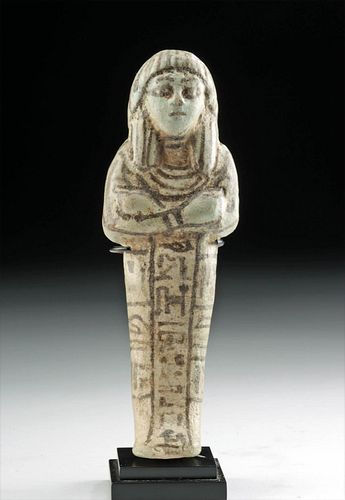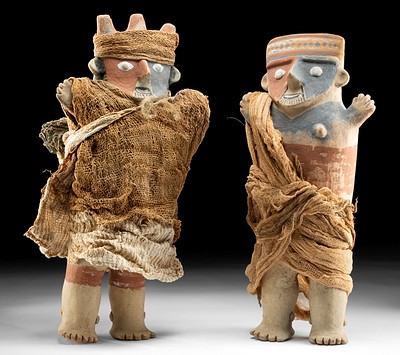Egyptian Faience Ushabti for Ptah-Em-May, TL'd
Lot 6
About Seller
Artemis Fine Arts
686 S Taylor Ave, Ste 106
Louisville, CO 80027
United States
Selling antiquities, ancient and ethnographic art online since 1993, Artemis Gallery specializes in Classical Antiquities (Egyptian, Greek, Roman, Near Eastern), Asian, Pre-Columbian, African / Tribal / Oceanographic art. Our extensive inventory includes pottery, stone, metal, wood, glass and textil...Read more
Estimate:
$4,500 - $6,750
Absentee vs Live bid
Two ways to bid:
- Leave a max absentee bid and the platform will bid on your behalf up to your maximum bid during the live auction.
- Bid live during the auction and your bids will be submitted real-time to the auctioneer.
Bid Increments
| Price | Bid Increment |
|---|---|
| $0 | $25 |
| $300 | $50 |
| $1,000 | $100 |
| $2,000 | $250 |
| $5,000 | $500 |
| $10,000 | $1,000 |
| $20,000 | $2,500 |
| $50,000 | $5,000 |
| $100,000 | $10,000 |
| $200,000 | $20,000 |
About Auction
By Artemis Fine Arts
May 19, 2022
Set Reminder
2022-05-19 10:00:00
2022-05-19 10:00:00
America/New_York
Bidsquare
Bidsquare : Fine Antiquities | Ethnographica | Fine Art
https://www.bidsquare.com/auctions/artemis-gallery/fine-antiquities-ethnographica-fine-art-9350
Featuring a very special collection of Fine Art from the Hollywood Hills, including Picasso & Rookwood ceramics! Also included are many fine examples of classical antiquities, ancient, and ethnographic art from cultures encompassing the globe. Artemis Fine Arts info@artemisfinearts.com
Featuring a very special collection of Fine Art from the Hollywood Hills, including Picasso & Rookwood ceramics! Also included are many fine examples of classical antiquities, ancient, and ethnographic art from cultures encompassing the globe. Artemis Fine Arts info@artemisfinearts.com
- Lot Description
Ancient Egypt, New Kingdom, late 19th Dynasty, ca. late 13th to early 12th century BCE. A gorgeous mold-formed faience ushabti covered in a layer of soft turquoise-hued glaze accentuated with applied black pigment. The delicate figure stands in mummiform with fused legs and feet, crosses both arms over the chest beneath a minimalist wesekh pectoral collar and holds a pick and hoe painted in black. Displayed on the back are a brick mold behind the right shoulder, a yoke and water pots over the left shoulder, and a seed bag centered on the back. The melancholy visage exhibits almond-shaped eyes with elongated exterior canthi beneath short brows, a protruding nose with black-painted nostrils, and a slender mouth, all beneath a finely striated double or "duplex" wig. While not fully translated, a column of black hieroglyphs as well as 3 transverse lines of hieroglyphs provide the names of Osiris as well as the deceased - Ptah-em-may. Size: 1.63" W x 4.88" H (4.1 cm x 12.4 cm); 5.3" H (13.5 cm) on included custom stand.
Ushabti dolls are figures shaped like adult male or female mummies wearing traditional ancient Egyptian headdresses. The ancient Egyptians believed that after they died, their spirits would have to work in the "Field of Reeds" owned by the god of the underworld, Osiris. As a result, they are frequently depicted with arms crossed, holding picks and hoes, with baskets on their backs. This meant that the task of agricultural labor was required by all members of society, from workers to pharaohs. The wealthier nobility in Egyptian society were able to have ushabti made of faience, though wood was a more economical option for members of lower classes. However, the overall size of this example suggests that this was meant for an individual of importance. During the Pharaonic period, they had become so necessary and elaborate that some tombs contained one worker for every day of the year and thirty-six overseers, each responsible for ten laborers. Workers like these are from that period of enormous proliferation, and are some of our best surviving insights into ancient Egyptian funerary practices.
This piece has been tested using thermoluminescence (TL) analysis and has been found to be ancient and of the period stated.
Provenance: private Boynton Beach, Florida, USA collection; ex-private Virginia, USA collection; ex-private M. Dehab collection, Brussels, Belgium, acquired prior to 1979
All items legal to buy/sell under U.S. Statute covering cultural patrimony Code 2600, CHAPTER 14, and are guaranteed to be as described or your money back.
A Certificate of Authenticity will accompany all winning bids.
PLEASE NOTE: Due to recent increases of shipments being seized by Australian & German customs (even for items with pre-UNESCO provenance), we will no longer ship most antiquities and ancient Chinese art to Australia & Germany. For categories of items that are acceptable to ship to Australia or Germany, please contact us directly or work with your local customs brokerage firm.
Display stands not described as included/custom in the item description are for photography purposes only and will not be included with the item upon shipping.
#170770Professional repair to legs around midway point, with resurfacing and overpainting along break lines that are nearly invisible. Professional repair and possible restoration to feet along center and proper right corner. Areas of minor roughness behind head and in other scattered areas. Light abrasions and fading to glaze pigment and hieroglyphs, with minor encrustations within some recessed areas, and light pitting commensurate with material type. Great preservation to most hieroglyphs, and nice remains of glaze pigment. TL drill holes beneath feet and behind left shoulder.Condition
- Shipping Info
-
All shipping is handled in-house for your convenience. Your invoice from Artemis Gallery will include shipping calculation instructions. If in doubt, please inquire BEFORE bidding for estimated shipping costs for individual items.
-
- Buyer's Premium



 EUR
EUR CAD
CAD AUD
AUD GBP
GBP MXN
MXN HKD
HKD CNY
CNY MYR
MYR SEK
SEK SGD
SGD CHF
CHF THB
THB
















